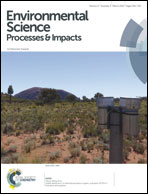Evaluating the applicability of a semi-continuous aerosol sampler to measure Asian dust particles
Abstract
A Korean prototype semi-continuous aerosol sampler was used to measure Asian dust particles. During two dust-storm periods, concentrations of crustal and trace elements were significantly enriched. Dust storms are one of the most significant natural sources of air pollution in East Asia. The present study aimed to evaluate use of a Korean semi-continuous aerosol sampler (K-SAS) in observation of mineral dust particles during dust storm events. Aerosol slurry samples were collected at 60 min intervals using the K-SAS, which was operated at a sampling flow rate of 16.7 L min−1 through a PM10 cyclone inlet. The measurements were made during dust storm events at an urban site, Gwangju in Korea, between April 30 and May 5, 2011. The K-SAS uses particle growth technology as a means of collecting atmospheric aerosol particles. Concentrations of 16 elements (Al, Fe, Mn, Ca, K, Cu, Zn, Pb, Cd, Cr, Ti, V, Ni, Co, As, and Se) were determined off-line in the collected slurry samples by inductively coupled plasma-mass spectrometry (ICP-MS). The sampling periods were classified into two types, based on the source regions of the dust storms and the transport pathways of the air masses reaching the sampling site. The first period “A” was associated with dust particles with high Ca content, originating from the Gobi desert regions of northern China and southern Mongolia. The second period “B” was associated with dust particles with low Ca content, originating from northeastern Chinese sandy deserts. The results from the K-SAS indicated noticeable differences in concentrations of crustal and trace elements in the two sampling periods, as a result of differences in the source regions of the dust storms, the air mass transport pathways, and the impact of smoke from forest fires. The concentrations of the crustal (Al, Ca, Ti, Mn, and Fe) and anthropogenic trace elements (Vi, Ni, Cu, Zn, As, Se, and Pb) were enriched significantly during the two dust storm periods. However, the crustal elements were enriched more during dust storm period “A”, whereas concentrations of the trace elements were higher during period “B”. Higher concentrations of K during dust storm period “B” could be ascribed to smoke from forest fires, in addition to soil dust emissions. This result is supported by a strong correlation between the crustal elements and the K concentrations, higher K/Al and K/Fe ratios in period “B” than those detected in the soil samples from the Gobi desert regions and Chinese sandy deserts, and the smoke from forest fires. The results of this study indicate that the K-SAS is a good candidate for revealing the dynamics in the concentrations of elemental species in Asian dust particles, as well as in urban and industrial aerosols, and for developing insight into their sources.


 Please wait while we load your content...
Please wait while we load your content...